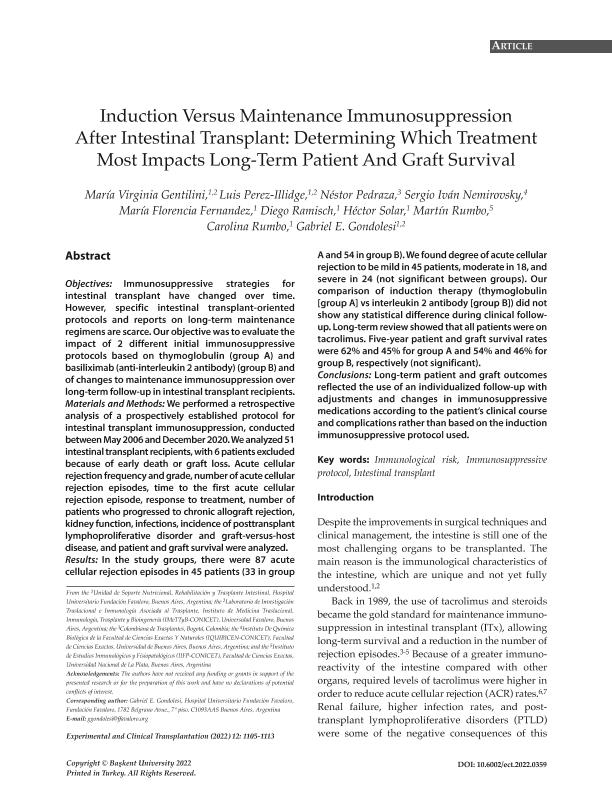Artículo
Induction Versus Maintenance Immunosuppression After Intestinal Transplant: Determining Which Treatment Most Impacts Long-Term Patient And Graft Survival
Gentilini, María Virginia; Perez Illidge, Luis; Pedraza, Néstor; Nemirovsky, Sergio Ivan ; Fernandez, María Florencia; Ramisch, Diego; Solar, Héctor; Rumbo, Martín; Rumbo, Carolina; Gondolesi, Gabriel Eduardo
; Fernandez, María Florencia; Ramisch, Diego; Solar, Héctor; Rumbo, Martín; Rumbo, Carolina; Gondolesi, Gabriel Eduardo
 ; Fernandez, María Florencia; Ramisch, Diego; Solar, Héctor; Rumbo, Martín; Rumbo, Carolina; Gondolesi, Gabriel Eduardo
; Fernandez, María Florencia; Ramisch, Diego; Solar, Héctor; Rumbo, Martín; Rumbo, Carolina; Gondolesi, Gabriel Eduardo
Fecha de publicación:
12/2022
Editorial:
Baskent Univ
Revista:
Experimental And Clinical Transplantation
ISSN:
1304-0855
Idioma:
Inglés
Tipo de recurso:
Artículo publicado
Clasificación temática:
Resumen
Objectives: Immunosuppressive strategies for intestinal transplant have changed over time. However, specific intestinal transplant-oriented protocols and reports on long-term maintenance regimens are scarce. Our objective was to evaluate the impact of 2 different initial immunosuppressive protocols based on thymoglobulin (group A) and basiliximab (anti-interleukin 2 antibody) (group B) and of changes to maintenance immunosuppression over long-term follow-up in intestinal transplant recipients. Materials and Methods: We performed a retrospective analysis of a prospectively established protocol for intestinal transplant immunosuppression, conducted between May 2006 and December 2020. We analyzed 51 intestinal transplant recipients, with 6 patients excluded because of early death or graft loss. Acute cellular rejection frequency and grade, number of acute cellular rejection episodes, time to the first acute cellular rejection episode, response to treatment, number of patients who progressed to chronic allograft rejection, kidney function, infections, incidence of posttransplant lymphoproliferative disorder and graft-versus-host disease, and patient and graft survival were analyzed. Results: In the study groups, there were 87 acute cellular rejection episodes in 45 patients (33 in group A and 54 in group B). We found degree of acute cellular rejection to be mild in 45 patients, moderate in 18, and severe in 24 (not significant between groups). Our comparison of induction therapy (thymoglobulin [group A] vs interleukin 2 antibody [group B]) did not show any statistical difference during clinical followup. Long-term review showed that all patients were on tacrolimus. Five-year patient and graft survival rates were 62% and 45% for group A and 54% and 46% for group B, respectively (not significant). Conclusions: Long-term patient and graft outcomes reflected the use of an individualized follow-up with adjustments and changes in immunosuppressive medications according to the patient’s clinical course and complications rather than based on the induction immunosuppressive protocol used.
Palabras clave:
IMMUNOLOGICAL RISK
,
IMMUNOSUPPRESSIVE PROTOCOL
,
INTESTINAL TRANSPLANT
Archivos asociados
Licencia
Identificadores
Colecciones
Articulos(IIFP)
Articulos de INST. DE ESTUDIOS INMUNOLOGICOS Y FISIOPATOLOGICOS
Articulos de INST. DE ESTUDIOS INMUNOLOGICOS Y FISIOPATOLOGICOS
Citación
Gentilini, María Virginia; Perez Illidge, Luis; Pedraza, Néstor; Nemirovsky, Sergio Ivan; Fernandez, María Florencia; et al.; Induction Versus Maintenance Immunosuppression After Intestinal Transplant: Determining Which Treatment Most Impacts Long-Term Patient And Graft Survival; Baskent Univ; Experimental And Clinical Transplantation; 20; 12; 12-2022; 1105-1113
Compartir
Altmétricas



